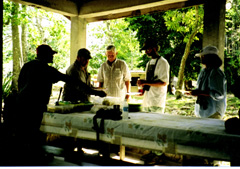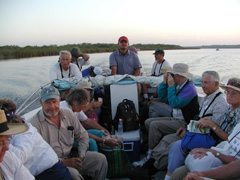Corozal, Belize, to Lamanai, Feb. 19-25
After several hours of border-crossing formalities, we entered Belize. This tiny country (formerly British Honduras) is smaller than Massachusetts and has fewer than 300,000 people. Belizeans are of mixed Native American, Hispanic, and African descent. They speak English and/or a lilting Creole. Most of them are very poor. Yet since independence in 1981 a democratically elected leadership rooted in the colonial civil service has provided Belize with enlightened environmental policies and a creditable infrastructure, including a limited network of very good roads. A rousing electoral struggle during our visit maintained the established leadership in power. There are only a half dozen towns of any size.
At Corozal near the border we settled into a comfortable RV park on the lovely waterfront. This was our base throughout our stay. While the big rigs remained here, the smaller rigs, pickup trucks, and mini-SUVs carried us on day excursions through northern Belize, and later to a secondary base at Dangriga for excursions in south-central Belize. In Corozal as elsewhere most enterprises were on a mom-and-pop scale, and the only establishments we frequented were a tiny grocery and a purveyor of superb pizza and beer.
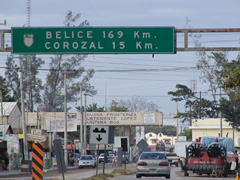 |
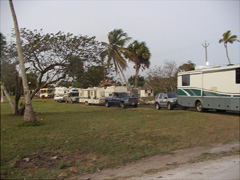 |
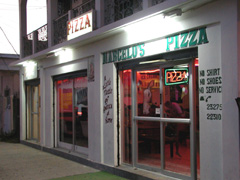 |
| Approaching
the border (F) |
Henry's RV
park (F) |
World class
pizza (F) |
Our first expedition was to the Crooked Tree Sanctuary, some forty miles to the south. Birding this great expanse of lake and marsh by boat, we thrilled to such tropical sensations as Yellow-headed Vulture, Snail Kite, and the imposing Jabiru Stork.
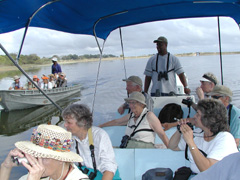 |
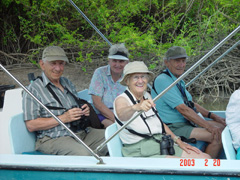 |
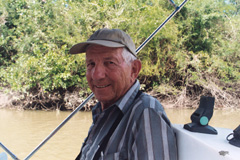 |
| (by
row) Virginia Landeck, June Hoyle & Pat Coe, Cecile & Steve
Magyar, Carolyn & Charlie (F) |
Charlie
& Carolyn, Cecile & Steve Magyar (F) |
Himself (F) |
After a pleasant lunch on the deck of a little waterside inn, the gang gathered to tell Carolyn good-bye. The next morning she had to fly back from the nearby airport to academic duties in the States, and meanwhile she would overnight here with Charlie and Harry while the others returned to Corozal. The ladies had feted her the previous evening with pink-icing carrot cake, and she now responded by reading an epic ballad on "Birding with Bert."
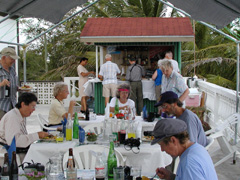 |
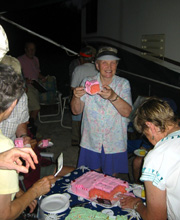 |
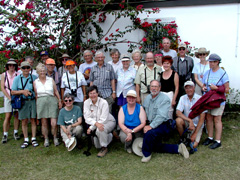 |
| Lunch (F) |
Let them eat
cake (H) |
The gang (F) |
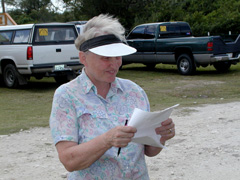 |
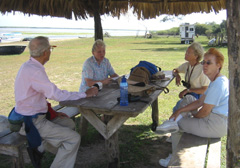 |
| "Birding
with Bert" (F) |
Final
good-byes (H) Wally Landeck, Carolyn, Virginia Landeck, Sue Hertz - and Harry |
After parting from Carolyn at the airport, Charlie hastened via back roads to overtake the gang at the remote La Milpa Field Station in northwestern Belize near the Guatemala border. This center for ecological research and tourism afforded us excellent accommodations, meals, and guides for several days of birding the unspoiled jungle of the Rio Bravo Conservation Area.
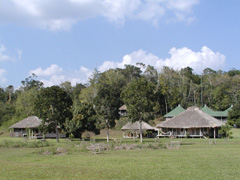 |
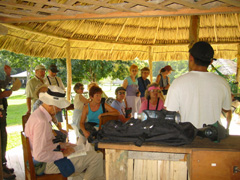 |
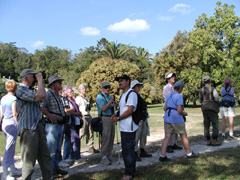 |
| La Milpa
Field Station (F) |
Meeting our
guides, dining ramada (H) |
Birding at
La Milpa (H) |
Before our next excursion from the Corozal base, Charlie revisited the airport to pick up his physician brother Phil, who flew in from Hendersonville, N.C., to take Carolyn's place (spatially only) for the rest of the Belize stay. With an election pending, Phil was startled on the way back to Corozal by the welcoming banner spanning the highway.
The following morning we traveled back down the road to the nearby sugar-mill town of Orange Walk. Here we embarked for a four-hour boat ride under a blazing tropical sun up the New River to the otherwise inaccessible Maya ruins (and birds) at Lamanai. The ruins were impressive, and Phil's initiation to birding was pretty exceptional. The return boat trip was a lot more pleasant as the sun sank, and after dark our boatman thrilled us by slewing at full speed through the invisible curves.
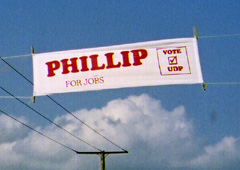 |
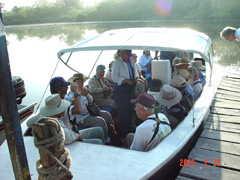 |
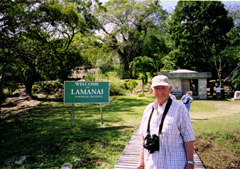 |
| Phil's
welcome to Belize (S) |
Embarking at
Orange Walk (Wr) |
Arrival --
"Whew, it's hot!" (S) |
